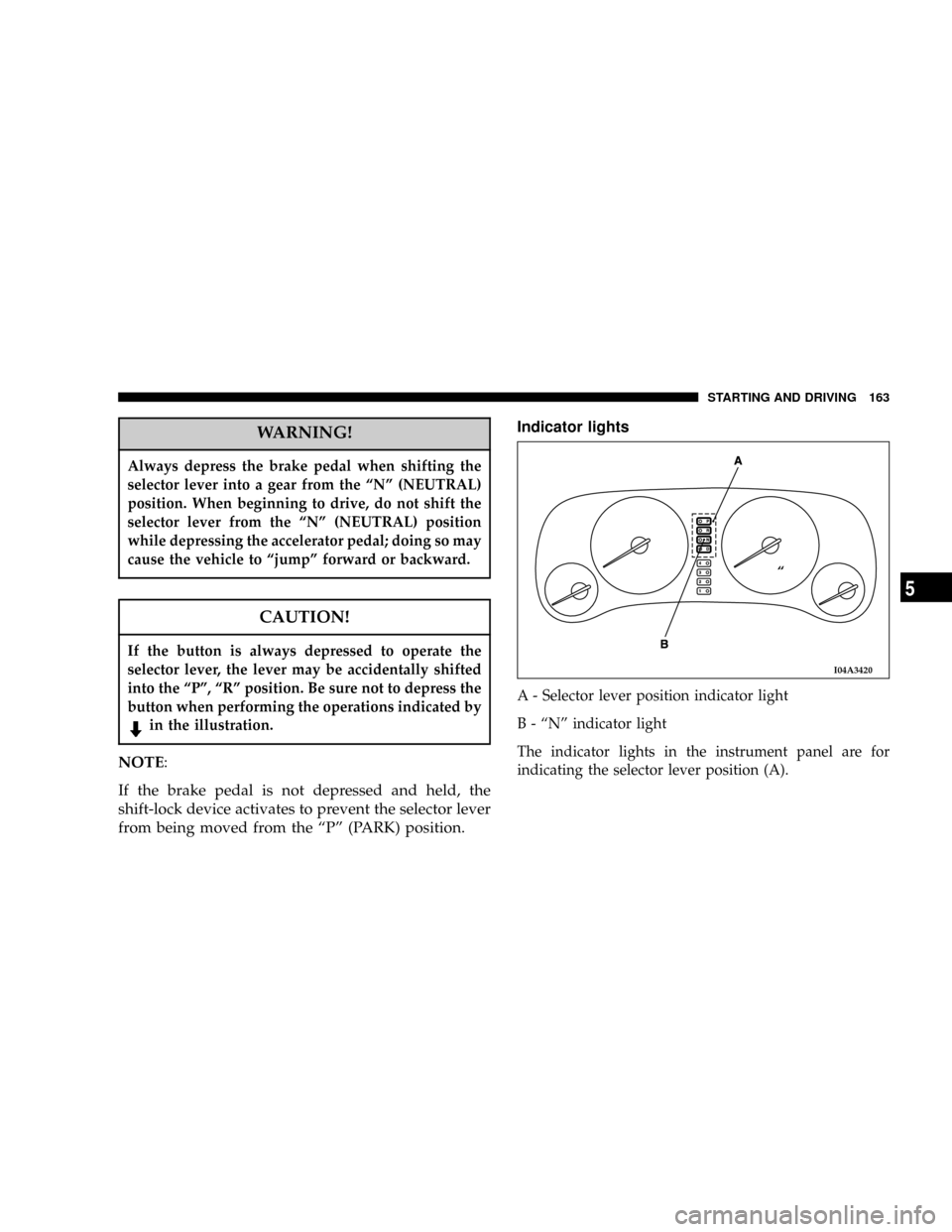DODGE STRATUS COUPE 2005 2.G Owners Manual
Manufacturer: DODGE, Model Year: 2005, Model line: STRATUS COUPE, Model: DODGE STRATUS COUPE 2005 2.GPages: 396
Page 161 of 396

CAUTION!
The electronically controlled transaxle system is
strictly intended to provide supplementary func-
tions. When driving downhill under certain condi-
tions, or immediately after starting when the auto-
matic transaxle is cold, no automatic shift-down may
be made. The driver should shift down to a low gear
(3rd gear or 2nd gear), which will permit the engine
to exert a braking effect.
NOTE: During the brake-in period or immediately after
re-connection of the battery cable, the vehicle may not
shift smoothly. This does not indicate a faulty transmis-
sion. The transaxle system must have a short period to
learn parameters for proper shifting. Shifting will become
smooth after the transaxle has been shifted several times
by the electronic control system.
Selector lever operation
The transaxle has 4 forward gears and 1 reverse gear.
The individual gears are selected automatically, depend-
ing on the position of the gear selector lever, the speed of
the vehicle, and the position of the accelerator pedal.
The selector lever has 29gates9: the main gate and the
manual gate.
NOTE: For information on manual gate operation,
please refer to ªAutostickº on page 165.
I04B0060
Main gate
Manual gate
STARTING AND DRIVING 161
5
Page 162 of 396

In the main gate, the selector lever has 4 positions and
is equipped with a lock button (A) to prevent inad-
vertent selection of the wrong gear.Button (A) must be pushed while the brake pedal is
depressed to move the selector lever.
Button must be pushed to move the lever.
Button need not be pushed to move the lever.
I04S1580
A
I04A1430
162 STARTING AND DRIVING
Page 163 of 396

WARNING!
Always depress the brake pedal when shifting the
selector lever into a gear from the ªNº (NEUTRAL)
position. When beginning to drive, do not shift the
selector lever from the ªNº (NEUTRAL) position
while depressing the accelerator pedal; doing so may
cause the vehicle to ªjumpº forward or backward.
CAUTION!
If the button is always depressed to operate the
selector lever, the lever may be accidentally shifted
into the ªPº, ªRº position. Be sure not to depress the
button when performing the operations indicated by
in the illustration.
NOTE:
If the brake pedal is not depressed and held, the
shift-lock device activates to prevent the selector lever
from being moved from the ªPº (PARK) position.Indicator lights
A - Selector lever position indicator light
B - ªNº indicator light
The indicator lights in the instrument panel are for
indicating the selector lever position (A).
I04A3420
ª
STARTING AND DRIVING 163
5
Page 164 of 396

If the ªNº indicator light in the instrument panel flashes,
there could be a malfunction with the automatic transaxle
system. Identify and take action in accordance with the
following procedures:
1. The ªNº indicator light flashes rapidly (twice per
second) in the ªDº or ªAutostickº range.
If this occurs, the automatic transaxle fluid is overheat-
ing. Park your vehicle in a safe place but do not turn off
the engine. Move the selector lever to the ªPº position
and open the hood. Keep the engine idling.
After a while, move the selector lever to the ªDº or
ªAutostickº position and confirm that the ªNº indicator
light stops flashing. It is safe to continue driving if the
ªNº light no longer flashes.
Be sure to carry out this check with the selector lever in
the ªDº or ªAutostickº position. The ªNº indicator light
warning function operates only in the ªDº or ªAutostickº
range.
If the ªNº indicator light continues flashing or flashes
intermittently, have your vehicle inspected by an autho-
rized dealer.2. The ªNº indicator light flashes slowly (once per
second) in the ªDº or ªAutostickº range.
The automatic transaxle safety device may be operating
due to a malfunction.
Have your vehicle inspected by an authorized dealer as
soon as possible.
Selector positions (Main gate)
P-PARK
This position locks the transaxle to prevent the vehicle
from moving. The engine can be started in this position.
R - REVERSE
Shift into this position only after the vehicle has come to
a complete stop.
CAUTION!
Never shift into the ªPº (PARK) or ªRº (REVERSE)
position while the vehicle is in motion. If the lever is
shifted into the ªPº or ªRº position while the vehicle
is in motion, the transaxle may be damaged.
164 STARTING AND DRIVING
Page 165 of 396

ªNº NEUTRAL
The engine may be started in this position.
WARNING!
²Never move the lever to the ªNº position while
driving since you could accidentally move the
lever into the(P(or(R(position, damaging the
transaxle.
²To prevent the vehicle from rolling when stopped
on a slope, the engine should be started in the ªPº
(PARK) position, not in ªNº (NEUTRAL).
²Always keep your foot on the brake pedal when
the vehicle is in ªNº (NEUTRAL), or when shift-
ing into or out of ªNº (NEUTRAL), to maintain
control.
ªDº DRIVE
This position is used for most city and highway driving.
Engine shifting is done automatically, depending on road
conditions.
Selector positions Manual gate Autostick
Autostick is a driver-interactive transaxle that offers
manual gear shifting capability to provide you with more
control. Autostick allows you to maximize engine brak-
ing, eliminate undesirable upshifts and downshifts, and
improve overall vehicle performance. This system can
also provide you with more control during passing, city
driving, cold slippery conditions, mountain driving,
trailer towing, and many other situations.
Whether the vehicle is stationary or in motion, Autostick
is selected by pushing the selector lever from the ªDº
position into the manual gate. To return to ªDº range
operation, push the selector lever back into the main gate.
In Autostick, gear shifts can be made rapidly by moving
the selector lever backward and forward. In contrast to a
manual transaxle, the Autostick allows gear shifts with
the accelerator pedal depressed.
STARTING AND DRIVING 165
5
Page 166 of 396

+ (UP) : Push the lever forward once to shift up one gear.
± (DOWN) : Pull the lever backward once to shift down
one gear.
CAUTION!
²Upward shifts do not take place automatically in
Autostick. The driver must execute upward shifts
in accordance with road conditions, make sure the
engine rpm remains below the red zone on the
tachometer.
²By rapidly moving the selector lever backwards
(DOWN) twice, it is possible to skip one gear, (i.e.
3rd to 1st or 4th to 2nd). Since sudden engine
de-acceleration or acceleration can cause a loss of
traction, downshifts must be made carefully in
accordance with the vehicle's speed.
NOTE
1. In Autostick, only the 4 forward gears can be selected.
To reverse or park the vehicle, move the selector lever to
the ªRº or ªPº position in the main gate.
2. To maintain the required levels of vehicle performance
and safety, the system may not allow certain gear shifts
when the selector lever is operated, such as 4th gear at
low speed.
I04S0170
166 STARTING AND DRIVING
Page 167 of 396

3. In Autostick, downward shifts are made automatically
when the vehicle slows down. When the vehicle stops,
1st gear is automatically selected.
4. When starting out on slippery roads, push the selector
lever forward into the + (UP) position. This puts the
transmission into 2nd gear and is better for starting out
on slippery roads. Push the selector lever to the ±
(DOWN) side to shift back to 1st gear.
5. Move the selector lever gently between the manual
and main gates and between positions in the manual
gate. Undue force could damage the selector lever.Indication lights
In Autostick, the currently selected gear is indicated by
the lights on the instrument panel.
NOTE: When Autostick is selected, the ªDº indicator
goes off.
Holding on an upgrade
To avoid transaxle overheating, never hold the vehicle
stationary on an incline by using the accelerator pedal.
Instead, use the brake pedal.
I04S0530
STARTING AND DRIVING 167
5
Page 168 of 396

Transaxle Reset Mode
The transaxle is monitored for abnormal conditions. If a
condition is detected that could cause damage, the trans-
axle automatically shifts into second gear. The transaxle
remains in second gear despite the forward gear selected.
Park (P), Reverse (R), and Neutral (N) will continue to
operate. This Reset feature allows the vehicle to be driven
to a dealer for service without damaging the transaxle.
If the problem has been momentary, the transaxle can be
reset to regain all forward gears.
²Stop the vehicle and shift into PARK (P).
²Turn the key to OFF then start the engine.
²Shift into ªDº and resume driving.
NOTE:Even if the transaxle can be reset, we recom-
mend that you visit a dealer at your earliest possible
convenience. Your dealer has diagnostic equipment to
determine if the problem could recur.
If the transaxle cannot be reset, dealer service is required.
MANUAL TRANSAXLE (IF SO EQUIPPED)
The shift pattern is shown on the gearshift lever. Depress
the clutch pedal fully while shifting gears.
NOTE: During cold weather, shifting may be difficult/
stiff until the transaxle lubricant has warmed up. This is
normal and not a sign of a problem.
I29A0020
168 STARTING AND DRIVING
Page 169 of 396

To start
Depress the clutch pedal fully and shift into 1st. Then
gradually release the clutch pedal while depressing the
accelerator pedal.
CAUTION!
²Do not move the gearshift lever into the ªRº
(REVERSE) while the vehicle is moving forward;
doing so will damage the transaxle.
²Do not rest your foot on the clutch pedal as this
will cause premature clutch wear or damage.
²Do not coast in the ªNº (NEUTRAL) position
(illegal in many states).
²Do not use the gearshift lever as a hand rest. This
can result in premature wear of the transaxle shift
forks.
NOTE
1. If it is hard to shift into 1st, depress the clutch pedal
again; the shift will then be easier to make.2. To shift into reverse from 5th gear, move the gearshift
lever to the ªNº (NEUTRAL) position, and then shift into
reverse. Never shift into the ªRº position when the
vehicle is moving.
Proper shift points
Always use care to change gears with the vehicle speed
matching the engine speed. Proper shifting will improve
fuel economy and prolong engine life.
CAUTION!
Avoid downshifting that may cause the tachometer
pointer to enter the red zone.
This puts the engine at risk of being damaged.
Upshifting
In order to efficiently utilize your manual transaxle for
both fuel economy and performance, it should be shifted
as listed below.
STARTING AND DRIVING 169
5
Page 170 of 396

At low altitude locations, shift at the vehicle speeds listed
for acceleration. Earlier upshifts during cruise conditions
(relatively steady speeds) will result in increased fuel
economy.
2.4 liter engine
Condition Upshift speeds
mph (km/h)
Acceleration Cruise
1st to 2nd 15 (25) 13 (20)
2nd to 3rd 23 (35) 18 (30)
3rd to 4th 34 (55) 33 (53)
4th to 5th 43 (70) 40 (65)
3.0 liter engine
Condition Upshift speeds
mph (km/h)
Acceleration Cruise
1st to 2nd 15 (25) 13 (20)
2nd to 3rd 23 (35) 21 (34)
3rd to 4th 34 (55) 33 (53)
4th to 5th 43 (70) 37 (60)
In high altitude locations, it should be upshifted as listed
below.
Condition Upshift speeds mph (km/h)
1st to 2nd 15 (25)
2nd to 3rd 25 (40)
3rd to 4th 40 (65)
4th to 5th 45 (70)
Downshifting
It is recommended that you downshift to a lower gear
according to the table as necessary to maintain desired
speeds.
Avoid downshifting at too high a speed; the engine may
suffer damage.
To maintain a safe speed and prolong brake life, shift
down to 2nd or 1st when descending a steep grade.
Downshifting is also important to avoid ªluggingº the
engine at too low a speed, such as when turning a corner
or when driving up a steep grade.
170 STARTING AND DRIVING